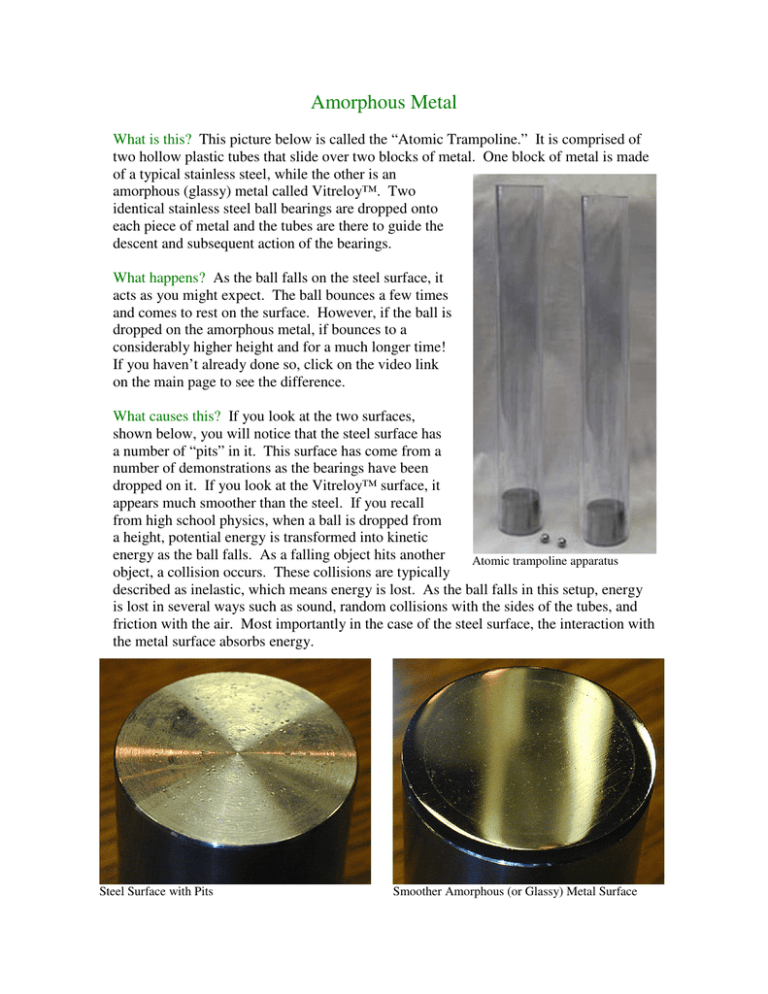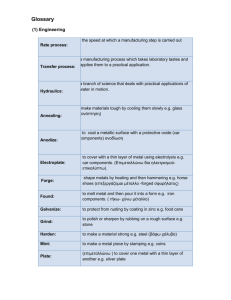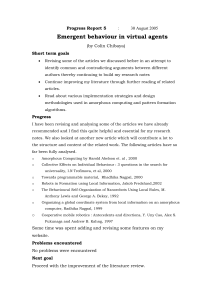Amorphous Metal
advertisement

Amorphous Metal What is this? This picture below is called the “Atomic Trampoline.” It is comprised of two hollow plastic tubes that slide over two blocks of metal. One block of metal is made of a typical stainless steel, while the other is an amorphous (glassy) metal called Vitreloy™. Two identical stainless steel ball bearings are dropped onto each piece of metal and the tubes are there to guide the descent and subsequent action of the bearings. What happens? As the ball falls on the steel surface, it acts as you might expect. The ball bounces a few times and comes to rest on the surface. However, if the ball is dropped on the amorphous metal, if bounces to a considerably higher height and for a much longer time! If you haven’t already done so, click on the video link on the main page to see the difference. What causes this? If you look at the two surfaces, shown below, you will notice that the steel surface has a number of “pits” in it. This surface has come from a number of demonstrations as the bearings have been dropped on it. If you look at the Vitreloy™ surface, it appears much smoother than the steel. If you recall from high school physics, when a ball is dropped from a height, potential energy is transformed into kinetic energy as the ball falls. As a falling object hits another Atomic trampoline apparatus object, a collision occurs. These collisions are typically described as inelastic, which means energy is lost. As the ball falls in this setup, energy is lost in several ways such as sound, random collisions with the sides of the tubes, and friction with the air. Most importantly in the case of the steel surface, the interaction with the metal surface absorbs energy. Steel Surface with Pits Smoother Amorphous (or Glassy) Metal Surface How does the steel absorb energy and what do the “ pits” have to do with it? Most metals, including stainless steel, have a crystalline structure. All crystalline solid structures contain missing atoms, called defects, impurity atoms of other elements, and misaligned planes of atoms called dislocations. The picture to the right helps to understand the repetitive, ordered, and organized nature of a crystalline structure. Under the force of the ball’s impact, some of this energy is Crystalline Atomic Structure transferred by making small pits on the surface of the stainless steel by moving planes of atoms and making dislocations. Dropping the ball permanently moves atoms in the steel plate. This is called plastic deformation. If the collision was more elastic, the planes of atoms would spring back into place and the energy would be transferred back to the ball and it would bounce higher. Vitreloy™, however, is an amorphous material, similar to glass, which means that the atoms are not arranged in any ordered structure. Rather, they have a tightly-packed, yet random arrangement like the picture on the left. Because there are no structured planes of atoms in an amorphous material, the atoms are gridlocked into the glassy structure, making the movement of groups of atoms (such a dislocation) very difficult. One consequence of this atomic gridlock is that some amorphous metals are very hard and have very high stiffness and a very high elastic modulus. The combination of hardness and elasticity of Vitreloy™ is an important factor in its many applications. As you can see by the video demonstration, the bearings and amorphous metal undergo a nearly elastic collision which is further evidenced by the lack of pits on the surface. Amorphous Atomic Structure History and Applications Amorphous metals were first developed and have been studied since the 1950’s, so they are not a new material. Metals have a high affinity for crystallization, however. In order to overcome this tendency, metals were subjected to cooling rates on the order of 104 or 105 °Celsius/second. This was an expensive process and only effective on thin films and small objects. Therefore, the potential applications of amorphous metal were limited. However, in the early 1990’ s, researchers from the California Institute of Technology, Drs. William Johnson and Atakan Peker, discovered that when metals with significantly different atomic radii (such as titanium, zirconium, nickel, copper and beryllium) are alloyed in certain percentages with each other, the inclination to crystallize is hindered. Upon cooling, the alloy solidifies into a glassy, amorphous solid structure. This is known, somewhat tongue-in-cheek, as the “ confusion principle.” Because of the atomic radii difference and the high number of different metals, the atoms are confused and don’ t know where to go to form crystals. You may have seen the “ infomercial” for the amorphous metal golf clubs that promise to fix the swing of the weekend duffer. These golf clubs and other sporting equipment made with amorphous metal are becoming more popular. In fact, Andre Agassi’ s current tennis racket of choice is made by Head and utilizes the amorphous metal in certain areas to provide more power to the tennis ball. Other applications include razor blades that last much longer, coatings in refineries and oil pipes, armor, ballistics, cell phone casings, anti-theft devices, medical scalpels, coatings on hip implants, skis, baseball and softball bats, and fine jewelry, such as watches and rings. The development of amorphous metal technology is still young and needs to be tested before it can be utilized in applications such as aviation and automobiles. Because of its properties, amorphous metal promises to make automobiles lower weight and more energy efficient. Citations: Interfacial Molecular Science Lab in the CME Department: http://glass.rutgers.edu Liquid Metal Industries: http://www.liquidmetal.com/index/default.asp Head Inc. Tennis: http://www.head.com/tennis/74.php Metglas, Inc.: http://www.metglas.com/ Crystal Structure Pictures: http://www.physics.brocku.ca/faculty/bose.html



